Philippine partisans: two civil wars on one country of the "seven thousand islands"
Colonization and resistance
History Europeans entered the Philippines in 1521, when the famous traveler Fernando Magellan landed on the island of Cebu, and then arrived on the neighboring island of Mactan, where he found his death, getting involved in a local civil war. However, already in 1543, the islands were called the Philippines - in honor of the Spanish king Philip, and in 1565, the first Spanish trading post appeared here. For three hundred and fifty years of Spanish rule in the Philippines, the local population has experienced the extremely significant linguistic, religious and cultural influence of distant Spain. Until now, the Spanish language has a certain distribution in the Philippines, at least the names of the majority of Filipinos of the Catholic religion - obviously of Spanish origin. As in any other colonial country, the Philippines gradually formed a national intelligentsia and an entrepreneurial stratum, represented by noble Filipinos who adopted Catholicism and were brought up in Spanish culture.
It is indicative that these people, whom the Spaniards wanted to see as the direct support of the colonial administration and whom official posts trusted, eventually became the main initiators of the beginning of the struggle of the Philippines for political sovereignty. An example for the Spanishized Filipinos was the series of revolutions in South America that led to the liberation of almost all the Spanish colonies in the New World and the emergence of new sovereign states. However, the Philippines to the end of the 1890's. Madrid remained a Spanish colony and Madrid, long weakened and having lost its former political influence, was not going to part with the two “pearls” of the Spanish crown - Cuba and the Philippines.
At the root of the Philippine struggle for independence at the end of the XIX century stood Jose Rizal. This unique person - a writer, a polyglot (he knew twenty languages, including several European ones) and a philosopher - graduated in Spain, but instead of becoming an official of the colonial administration, he chose the thorny path of a revolutionary. He founded and led the Philippine League - the first illegal organization that fought for the liberation of the Philippine Islands from the rule of the Spanish colonialists.
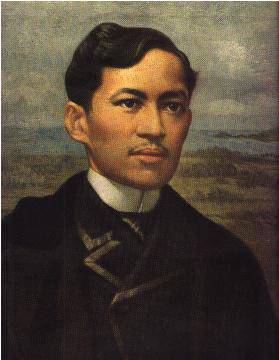
In 1896, José Rizal was arrested and executed for his anti-Spanish activities. However, in the same year, the ideological heirs of Risal, who were part of the secret society Katipunan, began the Philippine revolution, which ended with 1898 in the year when the islands were almost completely liberated from Spanish rule. However, since the Spanish-American war occurred in 1898, which became the logical conclusion of the growing US ambitions and their desire to seize Cuba, which was still a Spanish colony, several colonies of the latter, including Cuba, Guam, Puerto Rico and the Philippines, came under the control of the United States. Naturally, the Filipino independence fighters, who had just defended the right to political sovereignty in the biennial revolution, did not seek to go under the protectorate of the new owner. The Philippine-American war began, which lasted until 1901, and ended with the defeat of the Filipinos and the islands falling under the American protectorate. It was only in July 1946, in the wake of decolonization that began after the end of World War II, did the Philippines gain state sovereignty. However, the sovereign Philippine Republic almost immediately encountered a number of problems and contradictions.
Bangsamoro: the struggle of the Filipino "Moors"
A serious risk to the political stability of the Philippine state was the exacerbation of interfaith relations on the islands. The fact is that even before the Spanish colonization of the XVI century on the southern islands, especially in Sulu and Mindanao, a large Muslim community was formed. Islam, brought here by Arab and Malayan merchants from Indonesia, became the main religion for the peoples living in the south of the Philippines, which are often united under the name "Moro" (that is, the Moors - Muslims - as the Spaniards called the representatives of Islam of the Philippine people professing Islam). For three hundred and fifty years of colonization, the Spaniards were never able to conquer the created moro sultanates of Sulu, Maguindanao, and Buyian. The wars with the Muslims of the Southern Philippines continued for three and a half centuries, and although by the 1870 years. the Spanish colonial administration succeeded in getting recognition of the Spanish protectorate from the sultans; in fact, the Spanish authorities did not control the Muslim areas of the country.
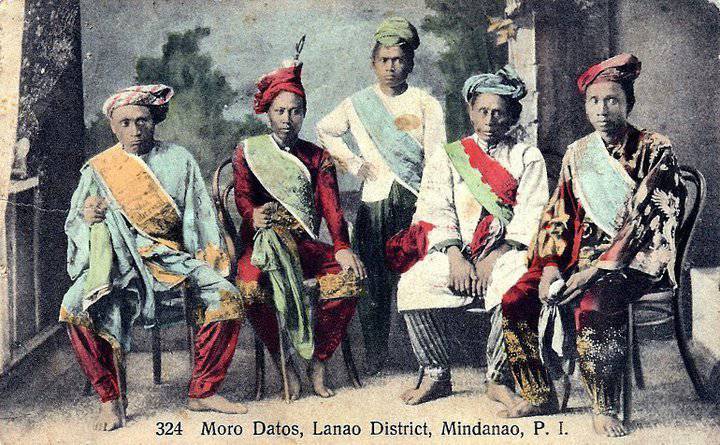
Since Islamic statehood in Sulu and Mindanao was formed even before the Spanish colonization, the proclamation of the state sovereignty of the Philippines considered the Muslim population of the southern islands as a chance to regain their own statehood. Although to date, Muslims make up only 5% of the population of the Philippines, they have been characterized by increased political activity throughout the independent existence of the republic, including in the form of armed resistance to the central government. The fact is that in addition to the long-standing political and religious tradition, isolated from the rest of the Philippines, the peoples of the south have always been famous for their belligerence. Thus, the samali were considered the most dangerous pirates in the coastal waters of the Philippines, the Maguindanao were famous throughout the archipelago as excellent gunsmiths - manufacturers of daggers - crises, spears and shields, Sulu gained fame as seafarers and also as gunsmiths.
Initially, the Catholic elite of the sovereign Philippine Republic, following the Spanish and American traditions, sought to suppress Muslim separatism in the south of the country. In response, the Moro continued armed resistance, which they, in fact, did not stop since the 16th century, fighting first against the Spaniards, then against the Americans, during the Second World War - against the Japanese, and after independence, against the central Philippine government.
Moro’s desire for independence, or at worst, national autonomy, was explained not only by confessional differences from the main part of the Philippine population. Religious discrimination of the Muslim population was aggravated by social contradictions. The fact is that back in the years of Spanish rule in the Philippines, the practice of resettling the peasant poor from the northern Christian provinces to Mindanao began. In addition to the migrant peasants, whose increase in numbers was intended to “balance” Christians and Muslims in the southern Philippines, rich Catholics, who were patronized by the Spanish government, and then the authorities of sovereign Philippines, also migrated to Mindanao. Catholics occupied the best lands, using connections in administrative structures and the police. As a result, by now the Muslim Moro were in the minority on their own territory - on the island of Mindanao. They also, despite the earliest traditions of statehood in the Philippines, turned into the most discriminated and backward socially and socio-culturally ethnic and religious minority of the country. In particular, among the Moro, more than half of adults do not know how to read and write, most of them live below the poverty line, the level of infant mortality is extremely high.
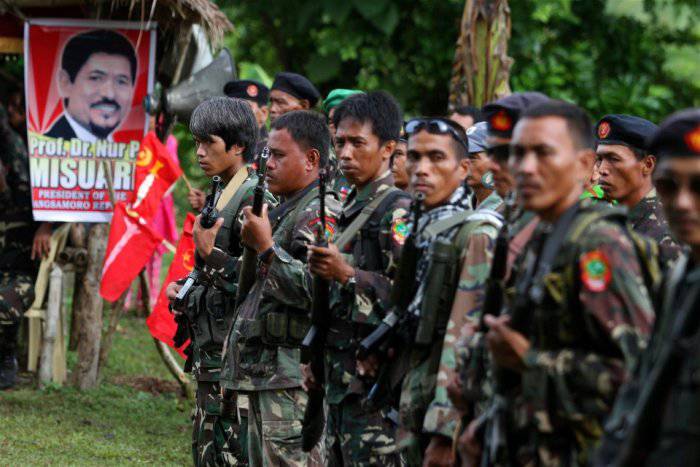
All these problems led to the formation of military-political organizations fighting for the rights of the Muslim population of Mindanao and other South Philippine islands. The largest and most authoritative of them was the Moro National Liberation Front, in the 1970-s. led an armed rebel struggle on the island of Mindanao. The creation of the Moro National Liberation Front is associated with the name Nur Misui (born 1939). This Sulu native came to political education at the University of the Philippines and from the end of the 1950-i became an activist of radical opposition movements. In 1960, the city of Misui created the Mindanao Independence Movement, which advocated the creation of a sovereign Islamic state in the southern region of the Philippines. Later, on the basis of this movement, the Moro National Liberation Front was created, in 1972-1976. leading the armed struggle against the Philippine government.
However, the peace agreement in Tripoli, signed in 1976, through the mediation of Muammar Gaddafi, did not at all entail a real cease-fire on both sides. As a result of the armed resistance, the supporters of Misuari succeeded in creating the Autonomous Region in Muslim Mindanao - the only territory in the Philippines that has its own government. In 1990, Missouri remained the governor of the Autonomous Region, and the Moro National Liberation Front was the ruling party. In 2001, the new president of the Philippines, Arroyo, removed the former rebel leader from the leadership of the region, and in 2007, Mr. Nour Misuiree was arrested on terrorism charges, but in 2009, he was released and continued his political activities.
The arrest and accusations of Misuari affected the political structure of the PLAF. The organization became radicalized again, and in 2012, the political sovereignty of the Bangsamoro state, which claimed the lands of the islands of Mindanao, Sulu, Palawan, was announced. It is assumed that Bangsamoro will be a federation of four states - Mindanao, Sulu, Bangsamoro and Compostela. Sulu and Bangsamoro will be organized as Islamic states, Mindanao as an egalitarian state for representatives of all ethnic and confessional groups, and Compostela as a socialist state for supporters of socialist and communist ideas. Thus, Nur Misuari and his supporters seek to attract not only Muslims - Moro, interested in the political sovereignty of the Southern Philippines, but also representatives of other religions - Catholics and Protestants, as well as animists. As we can see, a step is also being taken towards the Maoist and Trotskyist Communists influential in Mindanao, with which the NPF has been cooperating practically from the very beginning.
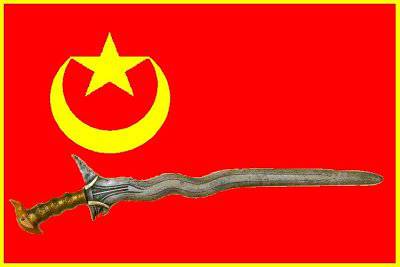
Nur Misuari, arguing about the prospects of Bangsamoro as an independent state in the southern Philippines, constantly draws attention to his “egalitarianism”, stressing that the Moro National Liberation Front is open not only to members of the Muslim minority, but also to any other people united with the moro’s struggle, regardless of their religious or political beliefs.
In 1981, the more radical Hashim Salamat group, known as the Islamic Moro Liberation Front, broke away from the Moro National Liberation Front. As the name implies, the PFM differed from the NPFM with a clearer orientation towards Islamic fundamentalism. IOFM proclaimed its goal to create the independent Islamic state Bangsamoro in the southern Philippines.
In contrast to NPMs, the PFM sees Bangsamoro as an exclusively Islamic state and completely rejects the possibility of negotiations with the central Philippine government. However, in 2011, the leaders of the PFD still retreated from their principles and held talks in Tokyo with the Philippine President Aquino. The latter promised to sign a peace agreement by 2016, recognizing the autonomy of Bangsamoro and creating opportunities for the development of Islamic forms of statehood on its territory, including Sharia justice.
From an even more radical position than the Islamic Moro Front for the Liberation, the Abu Sayyaf group is advocating. It was founded in 1991 by radical Islamists from the DPFM, who not only advocated the creation of an Islamic state of moro, but also called for “jihad against the infidels” by any means. The group commits terrorist acts and attacks on foreign workers and tourists, acquiring 1990-e - 2000-e. glory of the most radical Islamist organization of the Philippine Islands. One of the biggest terrorist attacks of Abu Sayyaf was the killing of more than a hundred people during an attack on a passenger ferry in 2004. In 2006, government forces stepped up military operations against the groups of the group, which killed one of its leaders, Gaddafi Janjalani (in 1998 His elder brother, the then leader of the organization, Abubakar Janjalani, was also killed.
The United States of America and the Philippine government are blaming Abu Sayyaf for collaborating with Al-Qaida. At the same time, it is significant that other national liberation organizations of the southern Philippines - the Moro National Liberation Front and the Moro Islamic Liberation Front seek to distance themselves from the grouping. This is explained not only by the fact that in “Abu Sayyaf” “organizations-veterans” of the national liberation struggle see the active and dynamically developing rival, but also by ideological contradictions. Despite decades of guerrilla warfare, the NPFM and now the IOFM are nevertheless “contact” organizations capable of participating in the negotiation process and making certain concessions. As for Abu Sayyaf, it is not all that simple. Radical Islamists, working with al-Qaeda, are unlikely to agree to the Philippine government, even if the latter offers to create special autonomy with separate Islamic components in the political and legal system.
Today, areas densely populated by Muslims on the islands of Mindanao are still a territory of heightened instability. The forests here are controlled by partisan formations, which forces the central government to keep a military force of 19 thousands of soldiers and officers there. In addition, after the 11 events of September 2001, the United States of America actively joined the fight against Islamic rebels in the Philippines, which also send instructors and military specialists to the southern islands to assist government forces in suppressing the partisan movement.
Although a peace agreement was signed between the Government of the Philippines and the Moro Islamic Liberation Front in 2012, it can hardly be said that the fighting on the southern islands will end. The war that took the lives of thousands of Filipinos in 150 continues to this day, only by going into the "sluggish" phase. The fact is that in addition to the Islamic Liberation Front, there are other rebel groups in the south of the Philippines that are not controlled by the IPFM leadership and have little contact with the central government. It is also impossible to deny the existence of another source of instability - the “red partisans” representing the radical communist organizations of the Philippines of the Maoist and Trotskyist persuasion.
"People's War" Maoist Communist Party
Back in 1930, the Communist Party of the Philippines was created under the leadership of Chrisanto Evangelista, bringing together local supporters of the teachings of Marx and Lenin. Two years after its creation, in 1932, the US administration of the Philippines banned the activities of the communists and the party went underground. It was the years of the underground struggle that influenced, on the one hand, the radicalization of the Communist Party, and, on the other hand, contributed to the crystallization of its cadre and the appearance of professional revolutionaries focused exclusively on illegal activities. During the Second World War, it was precisely at the initiative of the Communist Party that Hukbalahap was created - the People’s Anti-Japanese Army, which launched a partisan struggle against the Japanese forces occupying the Philippines. At least 25 thousand people - five thousand Japanese soldiers and officers, local policemen, collaborators, landowners and businessmen, representatives of hostile political groups became victims of the “huk”, as the “red partisans” were called.
The proclamation of independence of the Philippines in 1946 did not reassure the radical part of the Communists, who dubbed the country's government pro-American and continued the guerrilla war in the ranks of the established People’s Liberation Army. In 1948, the Communist Party of the Philippines once again went underground after formally banning its activities. At the same time, the authorities, deploying large-scale repression against the Communists, managed to knock out almost the entire party leadership. Only by the beginning of the 1960's. the communists managed to recover from the losses. By this time, much of the Filipino Communists, as well as the Southeast Asian communists in general, sympathized more with China Mao Zedong than with the more moderate line represented by the Soviet Union. This was explained both by the mental and territorial proximity of Chinese civilization, and by the active participation of Maoist China in financing radical communist parties in the countries of Indochina, Indonesia, Malaysia, India and the Philippines. Finally, it should be noted that the pro-Soviet communist leaders with pre-war experience either died during the Second World War or were destroyed during the period of political repression of the Philippine government against the Communists that followed the war. Among the radical youth, the ideas of the Great Helmsman were more successful than the Soviet model of building socialism and peaceful coexistence with the capitalist world.
It is with the activity of the Maoists that the beginning of the “red” guerrilla war in the Philippines, which lasts almost fifty years, is associated. The permanent leader of the Maoist Communist Party, formed on December 26 1968, is José Maria Sison. Like many other revolutionary figures, Sison was born in a wealthy landowner family - in the distant 1939 year. He was educated at the Faculty of Political Sciences of the University of Philippines, where he met his peer and fellow practitioner, the leader of the National Liberation Front, Moro Nur Misuri. In his youth, Sison showed great promise as a future scholar - a specialist in literary creativity, Jose Rizal. However, Jose Maria Sison chose the path of a revolutionary figure, in the capacity of which he was destined to go down in the history of the post-war Philippines.
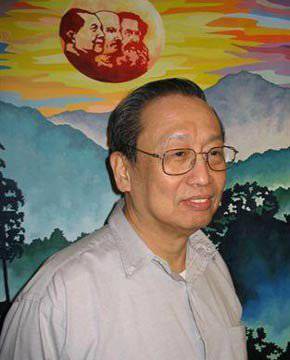
In 1962, Sison, then executive secretary of the Philippines-Indonesia Friendship Society, visited Indonesia, where he became acquainted with the activities of local Maoist communists and imbued with their ideas. Four years later, he visited Beijing, after which he set about creating a Maoist Communist Party in the Philippines. The officially updated Communist Party of the Philippines counts its history from 1968, why its abbreviation is spelled as “KPF (1968)”. Sison was able to attract to his side many warlords from among the veterans of Hukbalahap, who brought their fighting experience to the organization and were able to train Maoist youth from among students, urban and rural lumpen proletarians, in the methods of partisan warfare. In 1969, the New People’s Army (NNA) -Bagong Hukbong Bayan was created - the armed wing of the Communist Party of the Philippines, which until now has fought a partisan war against the Philippine government.
Like other Maoist organizations, in its daily activities the Communist Party of the Philippines is guided by combining the armed partisan struggle led by the New People’s Army and the construction of parallel power structures and public organization in areas controlled by the partisans. In particular, in the “liberated areas” the guerrillas are setting up a system of school education, medical services for the population, and at the same time “organizing committees of bario” (i.e. village councils) and “armed bario councils” (i.e., peasant self-defense units) are being created. KPF activities cover at least 800 municipalities of the country and 10 000 rural settlements in 70 from the 81 provinces of the country. Organized 100 guerrilla fronts, each of which covers from 6 to 8 municipalities.
According to the US Central Intelligence Agency, in 2013, the number of militants of the New People’s Army ranged from 6 to 10 thousand people. The Philippine military command in 2014 was more optimistic: according to the generals, there are approximately thousands of armed militants in the ranks of the Maoist insurgents by the current year. Naturally, the maintenance of such an army and the maintenance of its combat readiness requires a constant infusion of enormous funds. However, the Maoist rebels have long found a way out of the situation, taxing the so-called entrepreneurs and landowners operating in the territories under their control. "Revolutionary tax". In fact, a “revolutionary tax” is a certain amount that an entrepreneur must surrender to the cash office of the New People’s Army. Otherwise, he risks paying with health, business, and even life. Some of the funds received are directed to the social needs of the population in the territories under their control. It should be noted that the Maoist rebels really help the poorest peasantry of the Philippines by providing food and medical assistance, as well as interfering in labor disputes and acting as a kind of roof for peasants in conflicts with landowners and usurers.
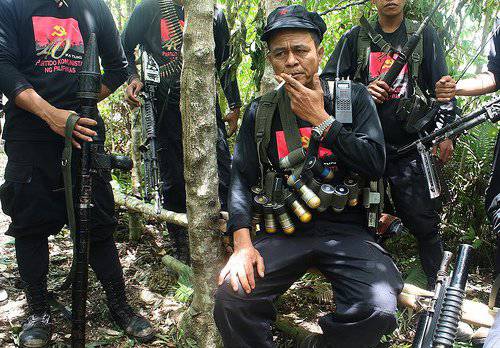
The popularity of the Maoist insurgents among the social lows of the Filipino village is explained by the fact that the New People’s Army in the “country of seven thousand islands” has long been called the “second power”. Unlike the Muslim separatists of the southern Philippines, it is much more difficult to come to an agreement with the communist guerrillas from the New People’s Army. With almost one hundred percent guarantee, the Filipino government will never accept the autonomy of the regions occupied by the New People’s Army because it fears that the Maoists A social experiment may be attractive to millions of disadvantaged people in the Philippines.
Concluding the conversation about the Filipino rebels, it should be noted that the Maoist New People’s Army is by no means the only left-wing organization leading an armed struggle against the Philippine government. So, back in 1980's. within the Communist Party of the Philippines, opposition began to form, ideologically closer to Trotskyism than Maoism. By the beginning of the 1990's. opposition-minded activists withdrew from the Maoist Communist Party, creating their own political organization in 1998 - the Revolutionary Workers' Party of the Philippines (RRPF). Ideologically, this party reoriented itself to the Trotsky Fourth International, becoming its Philippine representation.
In 2001, the branch of the RRPF, which operated on the island of Mindanao, also broke off and formed the RRPM - the Revolutionary Workers' Party of Mindanao. The revolutionary workers' party of the Philippines has its own armed forces - the revolutionary proletarian army - the Brigade of Alex Boncayo, also noted in the 1990-xNNXX-s. numerous armed attacks and terrorist attacks. The Mindanao Revolutionary Workers' Party, the Revolutionary People’s Army, also has its armed forces. The leader of the Revolutionary Workers' Party of Mindanao, Clara Maria Sanchez, in 2000, concluded a peace agreement with the government, which, however, does not interfere with the militants of the party not folding weapon and continued their partisan activities.
At present, the Philippines, like many other countries with similar political problems, is in a stalemate. On the one hand, it is obvious that the lack of real military success of the government in the fight against the rebels for more than half a century means that it is possible to seek a solution to the problem exclusively by peaceful means. On the other hand, the central government does not want to make concessions, especially with respect to the communist spectrum of partisan movements. If it is still possible to agree with the separatists, Moro, then any agreements with the "red partisans" will be very negatively perceived in the United States, which still tends to be not so much a partner as a patron of the millionth island nation of Southeast Asia. Since there is no way out of the current situation, the Philippines, as it should be assumed, will be doomed to a sluggish guerrilla war, which ultimately benefits many people — the government interested in receiving financial and military aid from the United States, and the army and police generals making money on operations with weapons and also squeezing the funds from the state treasury, and by the partisans themselves, who, as it should be supposed, are more comfortable with the status of the owners of the “liberated territories” than they judge s military tribunal in case of victory of the government troops.
Information